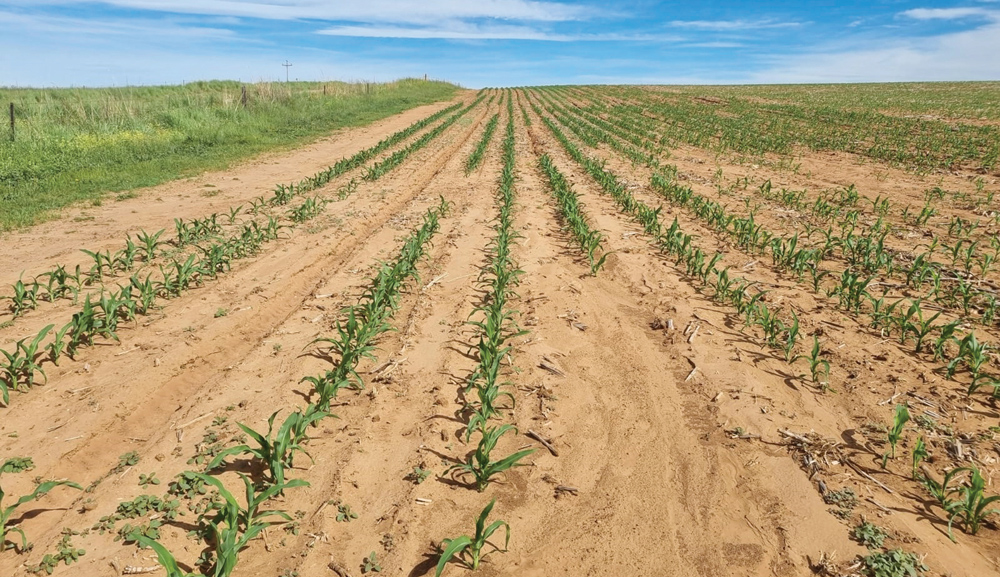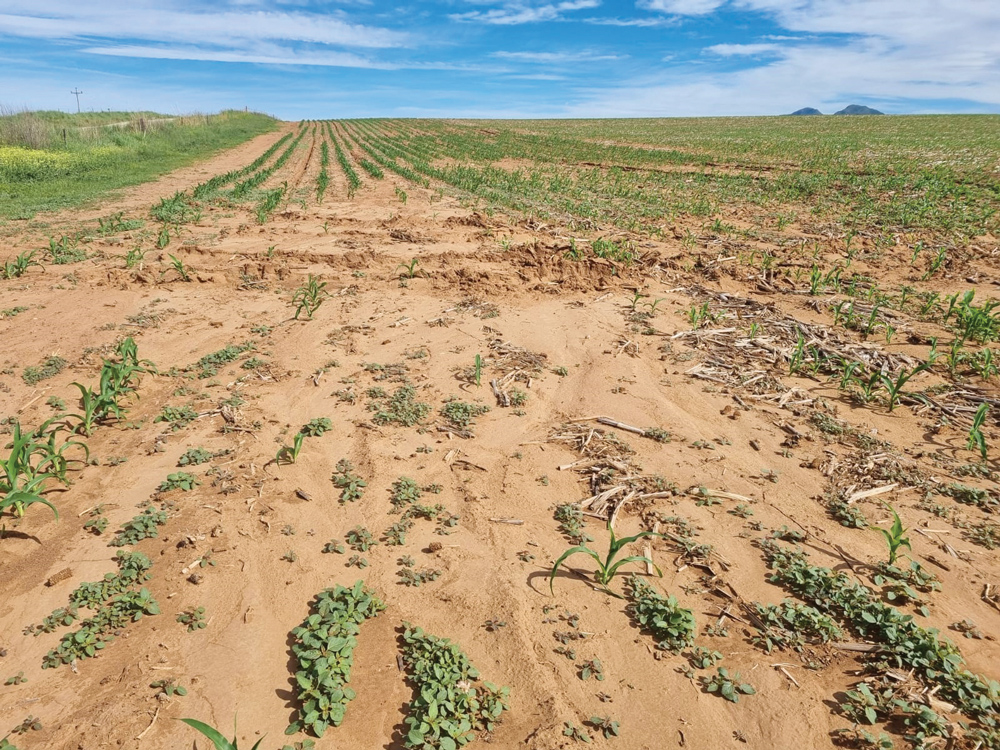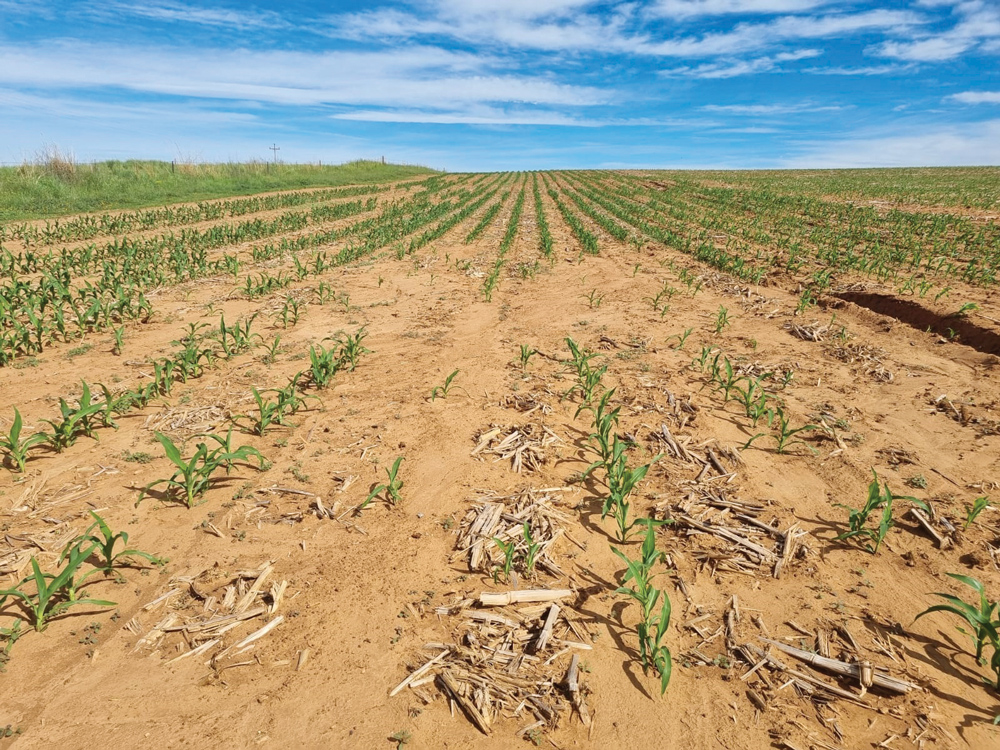February 2025
| ERIC WIGGILL, REGIONAL DEVELOPMENT MANAGER, PGP |
 |
IN SOUTH AFRICA, SOIL EROSION IS A SIGNIFICANT ISSUE THAT AFFECTS AGRICULTURAL PRODUCTIVITY AND LAND USE. THE PROBLEM OF LAND DEGRADATION DUE TO EROSION IS WIDESPREAD, PARTICULARLY IN AREAS WITH STEEP SLOPES, INTENSIVE AGRICULTURAL ACTIVITIES AND LIMITED SOIL CONSERVATION PRACTICES.
While exact figures on how much land is wasted specifically due to erosion vary, the South African government and research organisations estimate that approximately 10% to 20% of South Africa’s agricultural land is affected by erosion to varying degrees. Some studies suggest that about 12 million ha of land is affected by severe erosion, which includes both sheet erosion (gradual loss of soil over large areas) and gully erosion (deep, visible channels formed by water run-off).

Planting vertically at the end of the field down a slope causes erosion.
KEY CAUSES
By understanding these causes, farmers and land managers can implement appropriate erosion control measures and adopt sustainable practices to protect the soil, maintain fertility and prevent the long-term damage that erosion can cause to farmland.
CORRECTIVE STEPS
Fencing
Good fences will help with the management of grazing natural veld, grazing stalks and securing crops from wondering animals.
The carrying capacity refers to how many animals can be grazed per hectare. This figure depends on the climate, condition and type of grass. Ignoring these factors will lead to overgrazing, compaction and eventually erosion.
When maize stalks are grazed, four things primarily happen:
Therefore, animals on maize stalks must not be in the fields for the whole winter, as they will cause soil compaction. The breakdown of soil’s structure leads to the loss of valuable topsoil with wind and water erosion. With soil compaction, water will not be able to penetrate the soil and it will lead to dry and hard soils affecting soil cultivation and late planting times in the summer.
Fences not only help with veld management, but animal breeding programmes can also be implemented successfully, which is leading to higher profits. Well-maintained fences lead to super farmers, happy animals and good neighbours.
Contours and using sloped lands
When deciding to plant on a slope, you have to make sure you use the right tillage practices and that contours are in place to slow the water down. Fast-flowing water will erode topsoil and eventually make a gully.
It is advisable to plant grass like Kikuyu on contours, as it will hold the soil in place and act like a sponge. Rocks, tyres and logs will also help to slow down the water in existing erosion areas.
Remember, with contours you are not trying to collect the water and funnel it to one place, as this only makes the water flow faster, leading to bigger erosion issues and massive gullies. Slow the water down to ensure that it has time to penetrate the soil.
Tillage practices
The soil depth is especially important. Erosion is caused by the topsoil getting water-logged and not penetrating down into the lower levels. Lands must be ripped every third year to break up the plough pan and compacted areas, helping water move below the topsoil and root systems. It can then be moved to the lower levels of the soil profile, utilising the available water and nutrients.
This practice will lead to better usage of the whole soil profile by plants.
→ Top tip: Always rip, disc and plant across the slope.
Sandy soils
These soils break down quickly and are very prone to water and wind erosion – and dry out quickly.
→ Minimum tillage, strip-till or no-till practices are recommended with sandy soils.
→ Minimum or no grazing on stubble increases the soil’s ability to hold water by incorporating the stubble into the soil. It is therefore improving the soil’s ability to hold moisture and form bonds with the soil structure, lessening the chance of soil erosion and leaching out valuable nutrients.

About 20% of South Africa’s agricultural land is affected by erosion.
Increase vegetation cover
Rainwater harvesting techniques
By implementing a combination of these practices, you can significantly reduce erosion in clay soils and improve the long-term health and stability of the land.

Growing cover crops during off-seasons can preserve the soil.
Publication: February 2025
Section: Pula/Imvula